Editor’s Note: In 2017, the “Guidelines for Comprehensive Practical Activities Curriculum in Primary and Secondary Schools” issued by the Ministry of Education pointed out that comprehensive practical activities are interdisciplinary practical courses that start from the real life and development needs of students, discover problems from life situations, transform them into activity themes, and cultivate students’ comprehensive quality through exploration, service, production, and experience. Students can gain rich practical experience from individual life, social life, and contact with nature, forming and gradually enhancing their overall understanding of the intrinsic connections between nature, society, and self, with awareness and abilities in value recognition, responsibility, problem-solving, and creativity. The 2022 issued “Compulsory Education Curriculum Plan and Curriculum Standards (2022 Edition)” requires further strengthening the comprehensiveness and practicality of the curriculum, establishing interdisciplinary thematic learning activities, enhancing the interconnection between subjects, promoting the implementation of comprehensive courses, and strengthening practical aspects. In 2023, the “Opinions on Strengthening Science Education Work in Primary and Secondary Schools in the New Era” and the “Ministry of Education’s Opinions on Strengthening the Development and Management of Local and School-Based Curricula in Primary and Secondary Schools” were successively released, focusing on the fundamental task of moral education, requiring efforts in strengthening practice, stimulating students’ scientific interest, activating various educational resources, and promoting the integration of school and extracurricular activities, indicating that the development of school-based curricula should emphasize comprehensiveness, practicality, and selectivity. The Shanghai Municipal Education Commission issued the “Guiding Opinions on Implementing Project-Based Learning to Promote the Reform of Compulsory Education Cultivation Methods”, requiring project-based learning to be included in the school curriculum implementation plan. Whether it is the implementation of “double new” policies, science education, school-based curriculum construction, or new teaching models, they are all related to comprehensive practical activities and can work in the same direction for organic connection. The implementation of comprehensive practical activities in education and teaching has entered a new era and received broader attention. This issue publishes eight articles exploring the product and learning content research of educational equipment for comprehensive practical activities in primary and secondary schools from different perspectives, studying the adaptability of specific educational equipment to comprehensive practical activities and exploring possible application styles to further assist in the implementation of comprehensive practical activities.

The China Academy of Educational Sciences called for more social forces to collaborate in carrying out a rich variety of STEM innovation education activities in the “China STEM Education White Paper” published in 2017, hoping to cultivate students’ ability to use STEM education concepts to solve practical problems in real life, innovative thinking ability, scientific inquiry ability, and teamwork ability. In the intelligent era, simple knowledge transmission cannot meet educational needs; the essence of education has shifted to the cultivation of complex abilities, specifically the “21st Century Core Competencies” centered on expert thinking and complex interpersonal skills, which include Collaboration, Communication, Creativity, and Critical Thinking. To support the cultivation of 4C abilities, this study integrates the interdisciplinary concepts of STEM courses and the “learning by doing” educational philosophy of project-based courses, allowing students to immerse themselves in real problem situations and experience the process of solving complex problems. The project-based curriculum designed in this study emphasizes prompting students to learn and master knowledge, skills, and problem-solving abilities through the design, implementation, and completion of actual projects. In project-based courses, students typically collaborate in groups to participate in one or more interdisciplinary projects that simulate real-life situations, requiring students to apply their learned knowledge and skills to solve specific problems. To promote the popularization of STEM project-based courses and enhance learners’ competency development, affordable open-source hardware will serve as tools for learners to carry out scientific inquiry, engineering design, technology application, and mathematical modeling, playing a positive role in the curriculum. This study attempts to construct STEM course projects guided by the 5E teaching model and integrate open-source hardware into the classroom, cultivating learners’ ability to use open-source hardware to solve situational problems and design engineering projects, providing a reference for the design and practice of STEM course projects. Below, the design philosophy will be explained through the introduction of the “Design and Production of Mini Weather Stations” course project.

1. Curriculum Design
The 5E teaching model is an inquiry-based teaching model based on constructivist theory, including five stages: Engage, Explore, Explain, Elaborate, and Evaluate. In the scientific inquiry stage, learners need to participate in analyzing problems, proposing hypotheses, controlling variables, and planning each stage of the experiment, emphasizing effective reasoning and systematic thinking, supporting students’ judgment and decision-making to solve problems, which helps cultivate students’ critical thinking and problem-solving abilities; while the engineering design stage provides opportunities for cultivating creative thinking, encouraging students to collaborate with others in creative work and apply innovation. Furthermore, the first step of the 5E model requires students to conduct collaborative research within groups, encouraging practical learning and open communication among students, thus cultivating students’ collaboration and communication skills.
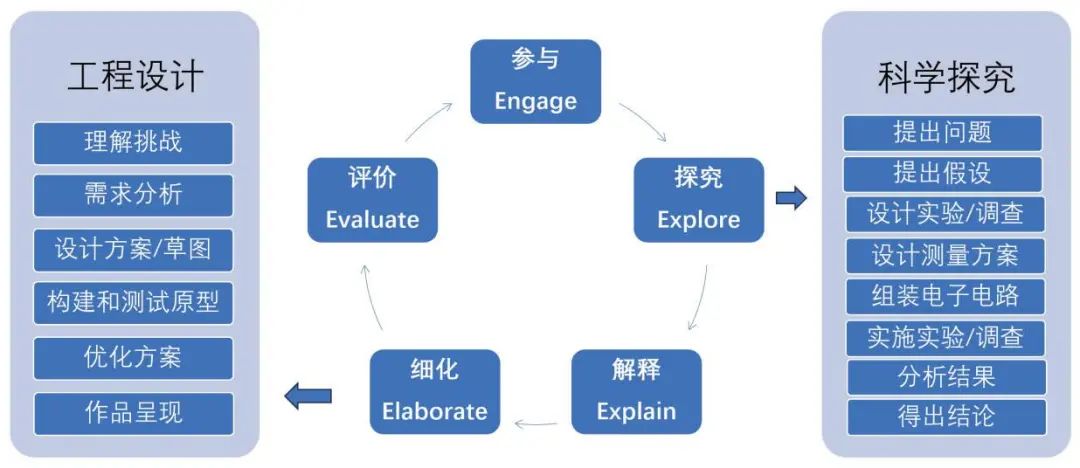
Figure 1: 5E Teaching Model for Cultivating 4C Abilities
In this study, the “Design and Production of Mini Weather Stations” project was designed based on the 5E teaching model. This project follows reverse engineering thinking, aiming to test and analyze existing mini digital weather stations and design new weather station products based on this, supporting the cultivation of students’ disciplinary knowledge and 4C abilities. The curriculum integrates meteorological knowledge such as “air temperature”, “air humidity”, “atmospheric pressure”, and “condensation”, mainly including three scientific inquiry activities: “Why do LED lights explode?”, “Does air conditioning reduce air humidity?”, and “Why does air pressure change in a syringe?” Learners use electronic components such as Arduino and sensors to design and produce weather monitoring equipment, exploring scientific concepts and laws through experiments. After mastering basic knowledge and skills related to electronic circuits, learning groups, with the help of learning materials and smart assistants, improve the internal functional components of the weather station and design the assembly of the weather station shell. After completing the design and production of the preset mini weather station, the learning groups conduct a “Weather Station Iterative Design Challenge”. To meet the air quality monitoring needs of the weather station, learning groups select sensor modules based on design standards and constraints, proposing design solutions that meet functional requirements and cost constraints, conducting competitions and peer evaluations among groups. The project lasts 8 weeks, divided into 16 class hours, with each class lasting 45 minutes. The specific activity content and arrangements are shown in Table 1.
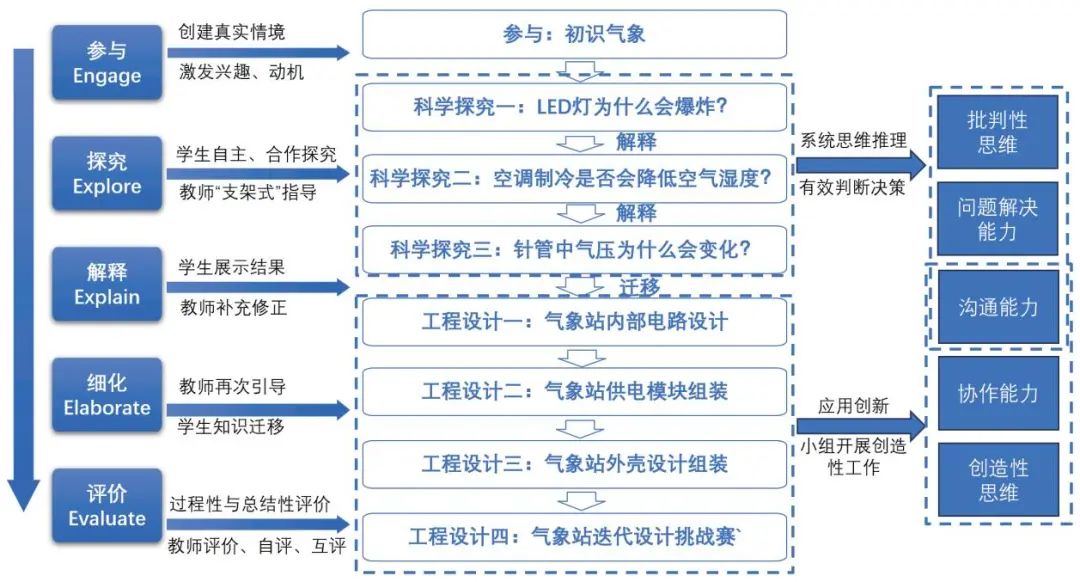
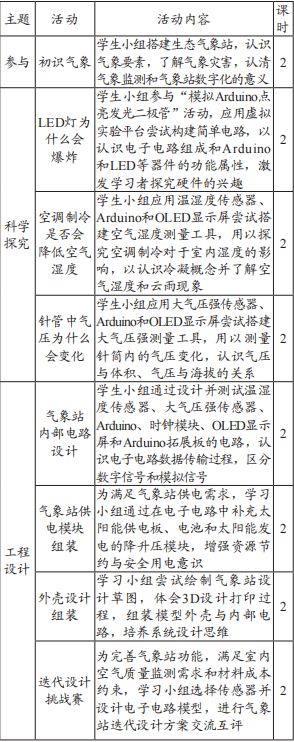

2. Course Case Introduction
Taking the third lesson “Does Air Conditioning Reduce Air Humidity?” as an example, the process of implementing teaching using the 5E inquiry-based teaching framework will be explained.
1. Learner Analysis
The implementation target of this course case is fifth-grade elementary school students, who have developed a certain level of logical thinking and abstract thinking abilities, capable of handling relatively complex information, but are relatively weak in hands-on practice and proactive awareness.
2. Learning Objectives
Learning groups collaboratively design and produce air humidity monitoring devices and use them to explore the relationship between air conditioning cooling time and air humidity, cultivating learners’ STEM knowledge literacy and 4C abilities; specific sub-goals are shown in Table 2.
Table 2: Sub-goal Description
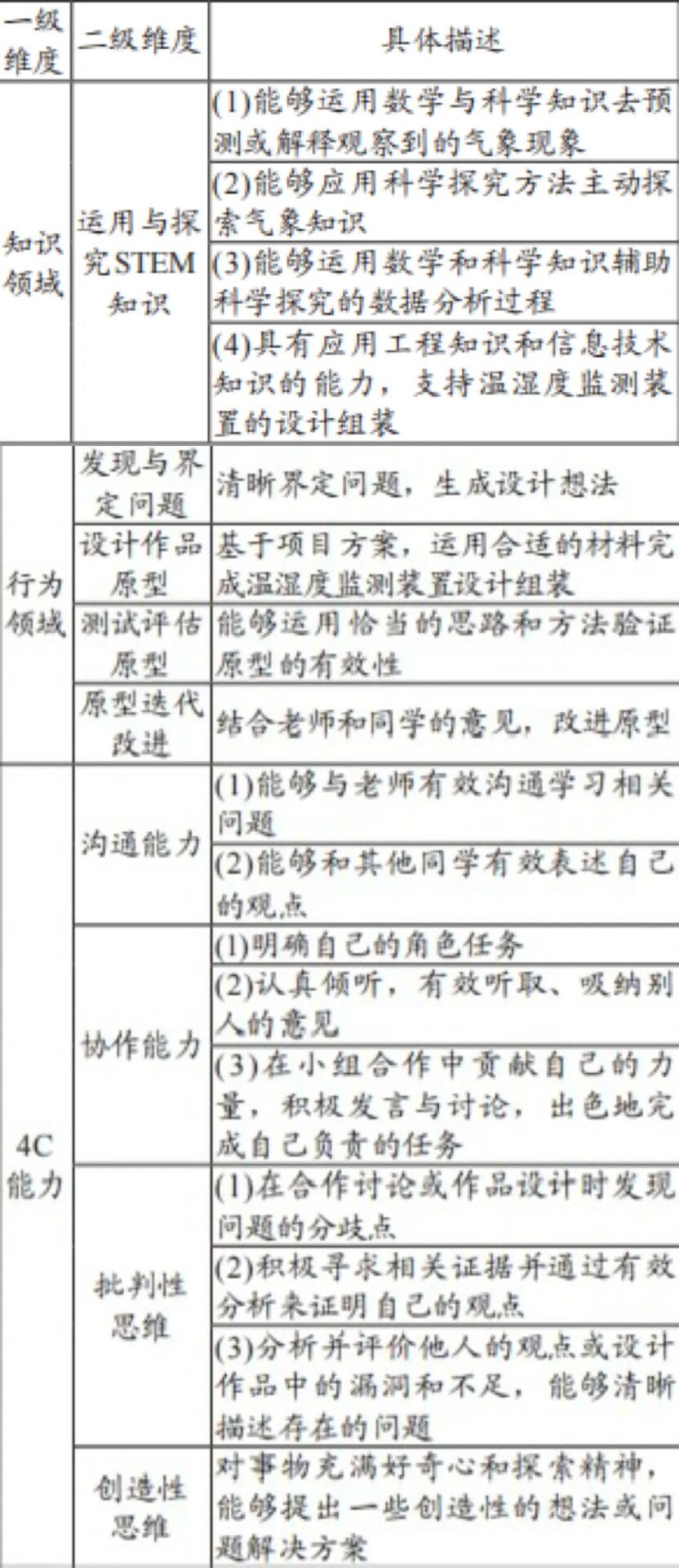
3. Learning Process
The learning process is shown in Table 3.

3. Result Analysis
This study analyzes the implementation results of the course from four dimensions: collaboration ability, communication ability, critical thinking, and creative thinking, observing the fluctuations in ability scores at different stages. The scoring data comes from student self-evaluations, peer evaluations, and teacher evaluations, with the scoring scale adapted from the 4C competency assessment scale developed by researchers such as Hwang. The scoring stages are before the project starts, after the scientific inquiry activity ends, after the scientific inquiry phase ends, and after the engineering design phase. As shown in Table 3, it was found that the overall trend of students’ 4C ability scores shows an upward trend, indicating that the project course design has a positive impact on the cultivation of students’ 4C abilities. In the final stage, the scores for communication ability, critical thinking, and collaboration ability all exceeded 4.7, while the score for creative thinking was lower at 4.6. Moreover, the scores for creative thinking at all stages were relatively low. This leads to further iterations of the project course design, providing students with more space for independent creation.
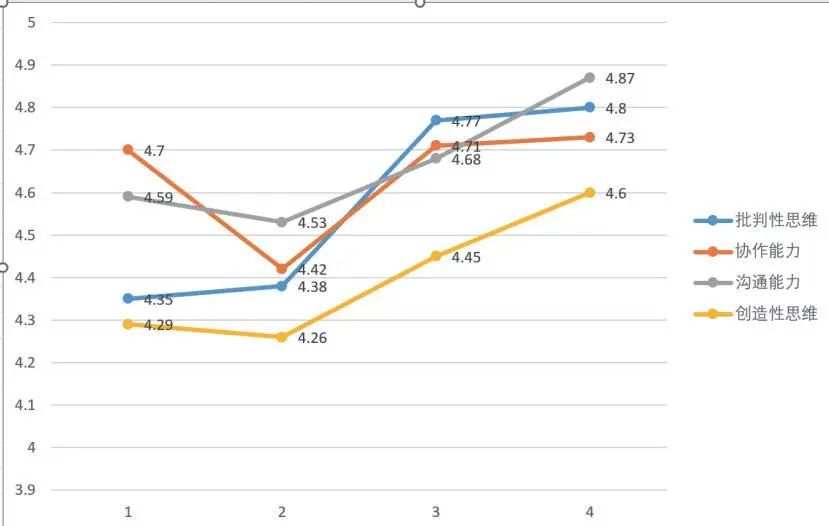
Figure 3: Changes in 4C Ability Scores

4. Conclusion
This study highlights the importance of STEM education, particularly through the project example of “Design and Production of Mini Weather Stations”, emphasizing the key role of STEM education in cultivating students’ 21st-century competencies and addressing future challenges. It deeply analyzes the potential value of open-source hardware in STEM education, especially in cultivating communication, collaboration, critical thinking, and creative thinking in 4C abilities. Open-source hardware not only provides practical learning opportunities but also facilitates students in applying theoretical knowledge to real projects, comprehensively cultivating key competencies. In this project course, the advantages of the 5E teaching model, reverse engineering thinking, and the 4C ability model are integrated, which not only aids in the transmission of disciplinary knowledge but also supports practical participation in projects, fostering learners’ innovation and creativity abilities. By organizing groups, assigning roles, and conducting peer evaluations and competitions, it successfully supports students’ teamwork and thinking cultivation. In summary, this study provides practical experience for the design of STEM course projects aimed at cultivating 4C abilities through open-source hardware development practices, offering innovative ideas and methods for the further development of STEM education.

References
[1] Zhang Hua. On the Connotation of Core Competencies [J]. Global Education Outlook, 2016, 45(4):10-24.
[2] Zhao Chengling, Zhao Wenjun, Jiang Zhihui. Design of the 5E Inquiry-Based Teaching Model for STEM Education [J]. Modern Educational Technology, 2018, 28(3):106-112.
[3] Luo Liang, Zhu Zhitian. Open Source Hardware: Leveraging Maker Education Practices [J]. China Educational Technology, 2015(4):7-14.
[4] Wang Jian, Li Xiujun. The Connotation of the 5E Teaching Model and Its Implications for Science Education in China [J]. Bulletin of Biology, 2012, 47(3):39-42.
[5] Koyunlu Ünlü Z, Dökme İ. A systematic review of the 5E model in science education: proposing a skill-based STEM instructional model within the 21st century skills [J]. International Journal of Science Education, 2022, 44(13):2110-2130.
[6] Teng Shuisheng. Exploration of Teaching Reform in Model Making Practice Based on Reverse Engineering Thinking [J]. Design, 2016(14):112-113.
[7] Havt, ChungLH, HanhNV, et al. Teaching Science Using Argumentation-Supported 5E-STEM, 5E-STEM, and Conventional Didactic Methods: Differences in the Learning Outcomes of Middle School Students [J]. Education Sciences, 2023, 13(3):247.
[8] Besemer SP. Creative product analysis to foster innovation [J]. Design Management Journal (Former Series), 2000, 11(4):59-64.
[9] Hwang GJ, Lai CL, Liang JC, et al. A long-term experiment to investigate the relationships between high school students’ perceptions of mobile learning and peer interaction and higher-order thinking tendencies [J]. Educational Technology Research and Development, 2018(66):75-93.
END
Author Information:
Li Fengming, Master’s student. East China Normal University, 200062.
Zhuang Tianwei, Undergraduate, Secondary Teacher. Chaochun Central Primary School, Putuo District, Shanghai, 200062.